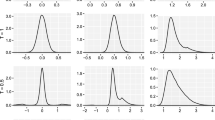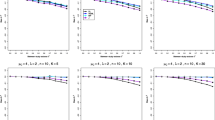Abstract
Several methods for imputing the number of responders from summary continuous outcome data in randomized controlled trials exist. A method by Furukawa and others was used in the quite common case that only such summary continuous outcome measures, but not the actual numbers of responders, are reported in order to estimate response rates (probabilities) for different treatments and response ratios between treatments in such trials. The authors give some empirical justification, but encourage search for theoretical support and further empirical exploration. In particular, a problem that needs to be addressed is that randomness in baseline score is not taken into consideration. This will be done in the present paper. Assuming a binormal model for the data, we compare theoretically the true response rate for a single treatment arm to the theoretical response rate underlying two versions of the suggested imputation method. We also assess the performance of the method numerically for some choices of model parameters. We show that the method works satisfactorily in some cases, but can be seriously biased in others. Moreover, assessing the uncertainty of the estimates is problematic. We suggest an alternative Bayesian estimation procedure, based directly on the normal model, which avoids these problems and provides more precise estimates when applied to simulated data sets.
Similar content being viewed by others
References
Anzures-Cabrera J, Sarpatwari A, Higgins J P (2011) Expressing findings from meta-analyses of continuous outcomes in terms of risks. Stat Med 30:2967–2985
Cipriani A, Barbui C, Salanti G, Rendell J, Brown R, Stockton S, Purgato M, Spineli L M, Goodwin G M, Geddes J R (2011) Comparative efficacy and acceptability of antimanic drugs in acute mania: a multiple-treatments meta-analysis. Lancet 8(378):1306–1315
Cipriani A, Furukawa T A, Salanti G, Geddes J R, Higgins J, Churchill R, Watanabe N, Nakagawa A, Omori I M, McGuire H, Tansella M, Barbui C (2009) Comparative efficacy and acceptability of 12 new-generation antidepressants: a multiple- treatments meta-analysis.Lancet 373:746–758
Cipriani A, Purgato M, Furukawa TA, Trespidi C, Imperadore G, Signoretti A, Churchill R, Watanabe N, Barbui C (2012) Citalopram versus other anti-depressive agents for depression. Cochrane Database Syst Rev 7:CD006534
Cohen J (1988) Statistical power analysis for the behavioral sciences, 2nd edn. Lawrence Erlbaum Associates
Cox D R, Snell E J (1989) Analysis of binary data. Chapman and Hall, London
da Costa B R, Rutjes A W, Johnston B C, Reichenbach S, Nüesch E, Tonia T, Gemperli A, Guyatt G H, Jüni P (2012) Methods to convert continuous outcomes into odds ratios of treatment response and numbers needed to treat: meta-epidemiological study. Int J Epidemiol 41(5):1445–1459
Filippini G, Vacchi L, D’Amico R, Di Pietrantonj C, Beecher D, Salanti G (2011) Comparative efficacy and acceptability of immunomodulators and immunosuppressants for multiple sclerosis: overview of Cochrane systematic reviews and multiple-treatments meta-analysis, Art. No.: CD008933. doi:10.1002/14651858. Cochrane database of systematic reviews, Protocol
Furukawa T A (1999) From effect size into number needed to treat. Lancet 1999(353):1680
Furukawa T A, Cipriani A, Barbui C, Brambilla P, Watanabe N. (2005) Imputing response rates from means and standard deviations in meta-analysis. Int Clin Psychopharm 20:49–52
Furukawa T A, Leucht S (2011) How to obtain NNT from Cohens d: comparison of two methods. PLoS One 6(4):e19070
Hamilton M (1960) A rating scale for depression. J Neurol Neurosurg Psychiatry 22:56–62
Hasselblad V, Hedges L V (1995) Meta-analysis of screening and diagnostic tests. Psychol Bull 117(1):167–78
Häuser W, Petzke F, Üeçeyler N, Sommer C (2011) Comparative efficacy and acceptability of amitriptyline, duloxetine and milnacipran in fibromyalgia syndrome: a systematic review with meta-analysis. Rheumatology (Oxford) 50(3):532–543
Klemp M, Tvete I F, Skomedal T, Gåsemyr J, Natvig B, Aursnes I (2011) A review and Bayesian meta-analysis of clinical efficacy and adverse effects of four atypical neuroleptic drugs compared with haloperidol and placebo. J Clin Psychopharmacol 31:698–704
Lunn D J, Thomas A, Best N, Spiegelhalter D (2000) WinBUGS—a Bayesian modelling framework: concepts, structure, and extensibility. Stat Comput 10:325–337
R Development Core Team (2011) R: A language and environment for statistical computing. Vienna, Austria. ISBN 3-900051-07-0
Suissa S (1991) Binary methods for continuous outcomes: a parametric alternative. J Clin Epidemiol 44:241–248
Author information
Authors and Affiliations
Corresponding author
Rights and permissions
About this article
Cite this article
Gåsemyr, J., Natvig, B. & Tvete, I.F. Estimating Response Ratios from Continuous Outcome Data. Methodol Comput Appl Probab 18, 137–151 (2016). https://doi.org/10.1007/s11009-014-9408-5
Received:
Revised:
Accepted:
Published:
Issue Date:
DOI: https://doi.org/10.1007/s11009-014-9408-5




